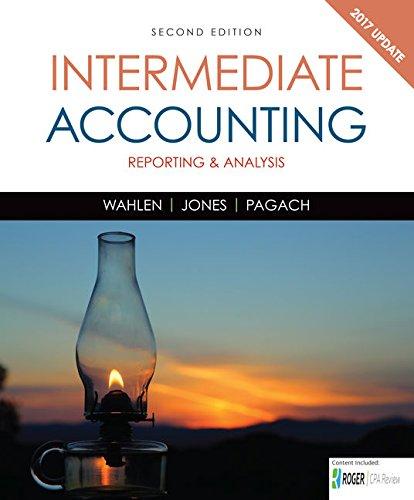
Cengagenowv2, 1 Term Printed Access Card For Wahlen/jones/pagach’s Intermediate Accounting: Reporting And Analysis, 2017 Update, 2nd
2nd Edition
ISBN: 9781337912259
Author: James M. Wahlen, Jefferson P. Jones, Donald Pagach
Publisher: Cengage Learning
expand_more
expand_more
format_list_bulleted
Concept explainers
Question
Chapter 18, Problem 3E
1.
To determine
Record the
2.
To determine
Explain the manner of reporting the deferred taxes in the
Expert Solution & Answer
Want to see the full answer?
Check out a sample textbook solution
Students have asked these similar questions
I need help with this general accounting question using the proper accounting approach.
I need help with this general accounting problem using proper accounting guidelines.
Please help me solve this general accounting question using the right accounting principles.
Chapter 18 Solutions
Cengagenowv2, 1 Term Printed Access Card For Wahlen/jones/pagach’s Intermediate Accounting: Reporting And Analysis, 2017 Update, 2nd
Ch. 18 - What source is used to determine income tax...Ch. 18 - Prob. 2GICh. 18 - Prob. 3GICh. 18 - Prob. 4GICh. 18 - Prob. 5GICh. 18 - Prob. 6GICh. 18 - What are the three characteristics of a liability,...Ch. 18 - Prob. 8GICh. 18 - When does a corporation establish a valuation...Ch. 18 - List the steps necessary to measure and record a...
Ch. 18 - Prob. 11GICh. 18 - Prob. 12GICh. 18 - Prob. 13GICh. 18 - Prob. 14GICh. 18 - Prob. 15GICh. 18 - Describe an operating loss carryforward. List the...Ch. 18 - Prob. 17GICh. 18 - Prob. 18GICh. 18 - Prob. 19GICh. 18 - Prob. 20GICh. 18 - Prob. 21GICh. 18 - Prob. 22GICh. 18 - Prob. 23GICh. 18 - Prob. 24GICh. 18 - Which of the following is not a cause of a...Ch. 18 - Which of the following is an argument in favor of...Ch. 18 - Prob. 3MCCh. 18 - Prob. 4MCCh. 18 - Prob. 5MCCh. 18 - Prob. 6MCCh. 18 - Prob. 7MCCh. 18 - Prob. 8MCCh. 18 - Prob. 9MCCh. 18 - Which component of current income is not disclosed...Ch. 18 - Parker Company identifies depreciation as the only...Ch. 18 - Refer to RE18-1. Assume that Parkers taxable...Ch. 18 - In the current year, Madison Corporation had...Ch. 18 - Refer to RE18-3. Prepare the additional journal...Ch. 18 - Turnip Company purchased an asset at a cost of...Ch. 18 - Prob. 6RECh. 18 - Compute Radish Companys taxable income given the...Ch. 18 - Prob. 8RECh. 18 - Prob. 9RECh. 18 - Kline Company has the following items of pretax...Ch. 18 - Prob. 11RECh. 18 - Cole Company had a deferred tax liability of 1,000...Ch. 18 - Prob. 1ECh. 18 - Prob. 2ECh. 18 - Prob. 3ECh. 18 - Prob. 4ECh. 18 - Prob. 5ECh. 18 - Prob. 6ECh. 18 - Prob. 7ECh. 18 - Prob. 8ECh. 18 - Prob. 9ECh. 18 - Prob. 10ECh. 18 - Prob. 11ECh. 18 - Temporary and Permanent Differences Lin has just...Ch. 18 - Prob. 13ECh. 18 - Prob. 14ECh. 18 - Prob. 15ECh. 18 - Prob. 16ECh. 18 - Prob. 17ECh. 18 - Prob. 18ECh. 18 - Prob. 19ECh. 18 - Prob. 20ECh. 18 - Uncertain Tax Position At the end of the current...Ch. 18 - Prob. 1PCh. 18 - Temporary and Permanent Differences In the current...Ch. 18 - Prob. 3PCh. 18 - Prob. 4PCh. 18 - Prob. 5PCh. 18 - Prob. 6PCh. 18 - Prob. 7PCh. 18 - Prob. 8PCh. 18 - Prob. 9PCh. 18 - Prob. 10PCh. 18 - Prob. 11PCh. 18 - Prob. 12PCh. 18 - Prob. 13PCh. 18 - Comprehensive At the beginning of 2016, Norris...Ch. 18 - Prob. 15PCh. 18 - Prob. 1CCh. 18 - Prob. 2CCh. 18 - Operating Losses The Internal Revenue Code allows...Ch. 18 - Interperiod and Intraperiod Tax Allocation Income...Ch. 18 - Prob. 5CCh. 18 - Prob. 6CCh. 18 - Permanent and Temporary Differences To implement...Ch. 18 - Prob. 8CCh. 18 - Prob. 9CCh. 18 - Prob. 10C
Knowledge Booster
Learn more about
Need a deep-dive on the concept behind this application? Look no further. Learn more about this topic, accounting and related others by exploring similar questions and additional content below.Similar questions
arrow_back_ios
SEE MORE QUESTIONS
arrow_forward_ios
Recommended textbooks for you
 Intermediate Accounting: Reporting And AnalysisAccountingISBN:9781337788281Author:James M. Wahlen, Jefferson P. Jones, Donald PagachPublisher:Cengage Learning
Intermediate Accounting: Reporting And AnalysisAccountingISBN:9781337788281Author:James M. Wahlen, Jefferson P. Jones, Donald PagachPublisher:Cengage Learning

Intermediate Accounting: Reporting And Analysis
Accounting
ISBN:9781337788281
Author:James M. Wahlen, Jefferson P. Jones, Donald Pagach
Publisher:Cengage Learning
Chapter 19 Accounting for Income Taxes Part 1; Author: Vicki Stewart;https://www.youtube.com/watch?v=FMjwcdZhLoE;License: Standard Youtube License